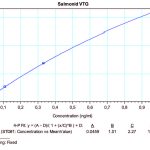TECO® Ultra Sensitive Salmonid Vitellogenin ELISA
$0.00
The TECO® Ultra Sensitive Salmonid Vitellogenin ELISA kit is a very sensitive enzyme linked immunosorbent assay for the quantitative determination of vitellogenin (VTG) in salmonid fish mucus or cell culture*.
Vitellogenin determination is one of the core endpoints in screening and testing for endocrine disrupting chemicals standardized in the OECD Guidlines for the testing of chemicals for estrogenic activity:
- OECD (2009), Test No.229
- OECD (2009), Test No.230
- OECD (2011), Test No.234
Vitellogenin determination is used in ecotoxicological studies to determine the effects of estrogenic compounds in the water.
Range: 0.012-1.0 ng/ml
Sensitivity: < 0.02 ng/ml
Incubation time: 4 hours
Sample Volume: 50 µl
Sample Preparation:
- Mucus: Collect as described in the TECO® Mucus Collection Set (TE1034). Mucus containing swabs can be stored several months at <-20°C.
- Cell culture: Store fresh samples immediately after collection at <-20°C until assayed.
Reference Values:
- Mucus levels are in the range of ng/ml.
*Additional assay validation may be required with the use of cell culture samples.
Kit Contents
| Antibody Coated Microassay Plate | 96-well plate (12×8 break-apart well strips coated with IgG directed against Salmonid VTG) |
|---|---|
| Standard Stock Solution | 17.5 ng, 2 vials |
| Control C1 | low control, 2 vials |
| Control C2 | high control, 2 vials |
| Wash Buffer | 1 x 30 ml, 50X (Dilute 1:50 with deionized water.) |
| Dilution Buffer | 1 x 55 ml. Ready to use. |
| Matrix Solution | 1 x 7 ml. Ready to use. |
| Biotinylated Antibody (Biotin-AB) | 1 x 12 ml. Ready to use. |
| Streptavidin Peroxidase Conjugate (SA-HRP Conjugate) | 1 x 12 ml. Ready to use. |
| TMB Substrate | 1 x 12 ml. Ready to use. |
| Stop Solution | 1 x 12 ml 1M HCl. Ready to use. |
Materials required but not supplied
- Pipettes, 10 μl – 1000 μl
- Multichannel pipettes, 50 μl – 100 μl
- Graduated cylinders for reconstituting and diluting reagents
- Manual Aspiration System or automatic washer for ELISA plates
- Distilled water
- Vortex mixer
- ELISA plate reader suitable for 96 well formats and capable of measuring at 450 nm (Reference: 590-650 nm)
- ELISA plate shaker (500 rpm)
- Software package for data generation and analysis
For mucus samples: The Mucus Collection Set (TE1034) which includes Extraction Buffer and validated Sampling Swabs is also required.
Downloads
- Package Insert (PDF)
- Brochure (PDF)
- Ultra Sensitive Salmonid Vitellogenin ELISA: A new tool allowing accurate determination of vitellogenin in male and juvenile fish (PDF)
- Cross-reactivity Chart (PDF)
- Comparison of different sample types in Vitellogenin testing (PDF)
- Technical Review: TECO® Vitellogenin ELISA System in Fish(PDF) (PDF)
Is there an ultrasensitive Perch ELISA available? Are there any suggestions for modifying the Perch ELISA if lower VTG values need to be detected in mucus?
The TECO® Perch Vitellogenin ELISA is the only commercially available ELISA for Perch/Perciformes. At the moment, there is not enough demand for an ultra-sensitive protocol. One option using the current protocol is to lower the dilution factor from 1:10 (50μL sample + 450μL extraction buffer) to 1:6 (50μL sample + 250μL extraction buffer). In development, this has been shown to increase the sensitivity of the assay appropriately.
How do I know mucus samples are not cross-contaminated by a nearby fish when I am collecting my samples?
It is recommended that mucus under the gill be swabbed, if cross contamination from nearby fish is a concern. This can be a concern with net fishing, where high- and low- level vitellogenin fish are in close proximity to each other.
How do I know mucus samples are not cross-contaminated with other environmental substances that may interfere with the assay and affect my results?
The antibodies used in the assays are very specific and do not recognize other components. Furthermore, the extraction buffer (500μL) used to dilute the mucus collected with the swab has a dilution effect that will dilute out a rare occurrence of an environmental contaminant. In development of the assay, aquarium water was used as a negative control and no contamination from the mucus samples was detected in comparison to the aquarium water.
Is it necessary to correct mucus (or blood, WBH) VTG against the protein alone?
While this is not necessary, the extraction buffer used in collecting mucus and the dilution buffer used in diluting blood and WBH are protein-free so they do allow for an easy parallel determination of proteins.
What is the calibrator material?
The calibrator material is biologic and not recombinant. It is prepared from serum that has been run through a column and separated via affinity chromatography. It is extensively validated and characterized using immunohistochemical staining, Western blot and SDS PAGE technology.
What is the composition of the matrix solution and what is its purpose in the assay?
The exact composition is proprietary information. The solution is responsible for activating the full reactivity of the plates.
What is the composition of mucus extraction buffer and sample dilution buffer?
The exact composition is proprietary information but both are protein-free solutions optimized for the assay.
What are the test strips coated with?
A polyclonal (affinity purified) antibody to vitellogenin.
What dilution should be used to prepare samples?
The best sample dilution will vary based on type of sample (blood, homogenate or mucus), species and exposure to test compound(s). Refer to the package insert and/or the Vitellogenin ELISA Crossreactivity chart for suggested dilution ranges. During assay evaluation/validation, it is recommended that several dilutions, based on the recommended range, be tested initially using a subgroup of samples. The results from assaying the subgroup at several dilutions can then be used to determine the best dilution for the rest of your samples based on your experimental design.
Can serum or plasma samples be used in the ELISA?
Yes, in all assays. Homogenate epidermal mucus samples may also be used.
What are the advantages of performing ELISA rather than molecular testing?
Molecular testing reflects the gene expression whereas ELISA assays detect the product, or actual effect, of this expression. Additionally, molecular assays tend to be time-consuming, costly and more sensitive to technique variables such that they require special laboratories with well-trained personnel.
How soon after exposure will the VTG protein be detected in mucus compared to blood/homogenate and compared to the detection of vtg gene expression?
This will vary depending on the substance and species, but in general, the VTG protein (gene expression) can be detected in mucus 48 hours after exposure to 2.5 ng/L EE2.
What are the advantages of using mucus rather than blood or whole body homogenate?
Mucus collection is non-invasive and non-destructive. It can be easier to collect from smaller fish. Collectingmucus does not require sacrificing the fish which means repeat sampling allows for studying induction kineticsby individual. Repeat sampling also allows for pre-exposure testing, making it possible to assess handling(stress)-related impacts on VTG induction. Additionally, research indicates the vitellogenin protein may be morestable in mucus. In blood, the vitellogenin protein can be especially prone to proteolytic cleavage.
Assay Principle
The TECO® Ultra Sensitive Salmonid Vitellogenin ELISA kit is a 96-well immuno-capture ELISA product. Mucus and cell culture samples are incubated with the vitellogenin specific antibody-coated microtiter plate. After unbound material is washed out, a polyclonal biotinylated antibody binds to the vitellogenin. In the following incubation step, a streptavidin-peroxidase conjugate binds to the biotinylated antibody. In the final substrate reaction, color development is directly proportional to the amount of vitellogenin in the sample.
Result Analysis
The standard range of the assay is between 0 and 1.0 ng/ml. A calibration curve can be established by plotting standard concentration on the x-axis (linear scale) against the absorbance of the standards on the y-axis (linear scale). The vitellogenin concentrations in samples can then be read off the calibration curve. A 4-parameter curve fit should be used for automatic data reduction. If samples were pre-diluted, the concentration can be obtained by multiplying the value read off the calibration curve by the dilution factor. A dilution correction for mucus is not necessary if only the 0.5 ml Extraction Buffer was added to the swab. Samples with higher absorbance values than Standard A should be tested again, pre-diluted with Dilution Buffer, and then this additional dilution should be taken in account for the concentration calculation.
TECO® Ultra Sensitiv Salmonid VTG ELISA Standard Curve Example – See Graph
Species
- Atlantic salmon (Salmo salar)
- Brown trout (Salmo trutta)
- Rainbow trout (Oncorhynchus mykiss)
- Chum salmon (Oncorhynchus keta)
- Pink salmon/humpback salmon (Oncorhynchus gorbuscha)
- Brook trout (Salvelinus fontinalis)
- Coregonus spec.
Background
In oviparous animals, vitellogenin (VTG) is an estrogen-induced yolk precursor protein mainly synthesized in the liver to be deposited in the maturing oocytes, where it is split in the yolk proteins lipovitellin 1, lipovitellin 2 and phosvitin. These yolk proteins serve as nourishment storage for the developing embryos. Non-physiological induction of vitellogenin in males or in juvenile fish is thought to indicate an estrogen mediated endocrine disruption. Therefore, VTG determination is one of the core endpoints in screening and testing for endocrine disrupting chemicals standardized in the OECD Guidelines for the testing of chemicals for estrogenic activity. Normally, vitellogenin is measured in blood samples or whole body homogenate (WBH) – both sample types require invasive and destructive treatment of the fish. Blood can be difficult to collect, in particular where very small fish are concerned and where the animals must survive sampling.
Recently, several cell types have been shown to produce VTG after estrogen stimulation, including those of the epidermal mucosa. Even though the VTG concentration in the skin mucus is an order of magnitude lower than in blood serum or in body homogenates (containing liver tissue), the skin mucosa is very well suited as a matrix for determining exogenous VTG induction caused by environmental chemicals with affinity to estrogen receptors. By using a highly sensitive ELISA in combination with a unique sampling and extraction system the determination of mucosa-born VTG determination has the following advantages:
- Simple and highly standardized sampling technique and sample preparation.
- Strictly defined matrix without protease contamination caused by non-target tissues or lymphatic fluid.
- Non-destructive and thereby allowing several subsequent samplings in order to record a kinetic of VTG induction with a maximum known to appear after 7 days of exposure. Therefore Mucosa test are fully compatible with acute as well as chronic OECD test methods.
- Epithelial organized epidermis is directly exposed to exogenous estrogens thereby allowing a direct comparison with in vitro test using estrogen sensitive vitellogenin producing fish cell lines.
- Lower degree of interference with endogenous VTG production (in females) and bio concentration or enterohepatic circulation of the effective estrogen (xenoestrogen) and thereby showing a clear dose response relationship.
- Stability of standards and samples if prescribed storage conditions are observed.
The TECO® Ultra Sensitive Salmonid Vitellogenin ELISA kitprovides a high-sensitivity ELISA option for researchers determining VTG protein concentration in fish mucus or cell culture samples.


